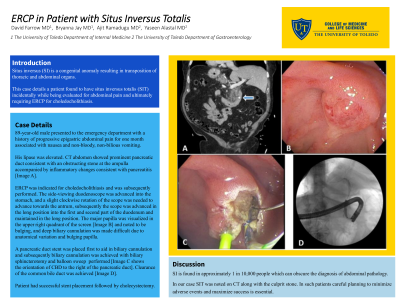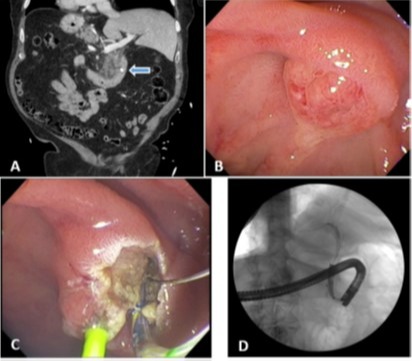Back


Poster Session B - Monday Morning
Category: Biliary/Pancreas
B0037 - ERCP in a Patient With Situs Inversus Totalis
Monday, October 24, 2022
10:00 AM – 12:00 PM ET
Location: Crown Ballroom

Has Audio

David Farrow, MD
University of Toledo
Toledo, Ohio
Presenting Author(s)
David Farrow, MD, Bryanna Jay, MD, Ajit Ramadugu, MD, Yaseen Alastal, MD, MPH
University of Toledo, Toledo, OH
Introduction: Situs inversus (SI) is a congenital anomaly resulting in transposition of thoracic and abdominal organs. SI is often found incidentally. We present a case of choledocholithiasis in a patient with situs inversus totalis (SIT). We highlight some technical considerations in performing ERCP for these patients which may increase procedural success. In addition, we included images showing the unique orientation of bile duct to the pancreatic duct.
Case Description/Methods: An 89-year-old male presented to the emergency department with progressive epigastric abdominal pain for one month associated with nausea and non-bloody, non-bilious vomiting. In the emergency department, the patient was found to have elevated lipase 1903 U/L, total bilirubin 1.7 mg/dL, and a CT abdomen showed changes of acute pancreatitis with a 7 mm obstructing stone at the ampulla (Image A). The CT also incidentally detected situs inversus totalis. After treatment of acute pancreatitis, patient underwent ERCP for removal of the common bile duct (CBD) stone. The patient was positioned in right semiprone position with the endoscopist positioned on the right side of the table. The side-viewing duodenoscope was advanced into the stomach, the gastric folds were followed with slight clockwise rotation of the scope until reaching the antrum. Long scope position was used to visualize and access the papilla. The major papilla was visualized in the upper right quadrant of the screen (Image B). Deep biliary cannulation was challenging so a pancreatic duct stent was placed first to aid in biliary cannulation. Subsequently, biliary cannulation was achieved with biliary sphincterotomy and balloon sweep performed (Image C shows the orientation of CBD to the right of the pancreatic duct). Clearance of the common bile duct was achieved (Image D). The patient tolerated the procedure well and underwent laparoscopic cholecystectomy during the same hospitalization.
Discussion: SI is found in approximately 1 in 10,000 which can obscure the diagnosis of abdominal pathology. Often imaging is necessary to fully determine organ position and existing anatomy. In our case SIT was noted on CT along with the culprit CBD stone that caused acute pancreatitis. Performing ERCP in this setting can be very challenging. In such patients, careful planning for ERCP to minimize adverse events and maximize success is essential.

Disclosures:
David Farrow, MD, Bryanna Jay, MD, Ajit Ramadugu, MD, Yaseen Alastal, MD, MPH. B0037 - ERCP in a Patient With Situs Inversus Totalis, ACG 2022 Annual Scientific Meeting Abstracts. Charlotte, NC: American College of Gastroenterology.
University of Toledo, Toledo, OH
Introduction: Situs inversus (SI) is a congenital anomaly resulting in transposition of thoracic and abdominal organs. SI is often found incidentally. We present a case of choledocholithiasis in a patient with situs inversus totalis (SIT). We highlight some technical considerations in performing ERCP for these patients which may increase procedural success. In addition, we included images showing the unique orientation of bile duct to the pancreatic duct.
Case Description/Methods: An 89-year-old male presented to the emergency department with progressive epigastric abdominal pain for one month associated with nausea and non-bloody, non-bilious vomiting. In the emergency department, the patient was found to have elevated lipase 1903 U/L, total bilirubin 1.7 mg/dL, and a CT abdomen showed changes of acute pancreatitis with a 7 mm obstructing stone at the ampulla (Image A). The CT also incidentally detected situs inversus totalis. After treatment of acute pancreatitis, patient underwent ERCP for removal of the common bile duct (CBD) stone. The patient was positioned in right semiprone position with the endoscopist positioned on the right side of the table. The side-viewing duodenoscope was advanced into the stomach, the gastric folds were followed with slight clockwise rotation of the scope until reaching the antrum. Long scope position was used to visualize and access the papilla. The major papilla was visualized in the upper right quadrant of the screen (Image B). Deep biliary cannulation was challenging so a pancreatic duct stent was placed first to aid in biliary cannulation. Subsequently, biliary cannulation was achieved with biliary sphincterotomy and balloon sweep performed (Image C shows the orientation of CBD to the right of the pancreatic duct). Clearance of the common bile duct was achieved (Image D). The patient tolerated the procedure well and underwent laparoscopic cholecystectomy during the same hospitalization.
Discussion: SI is found in approximately 1 in 10,000 which can obscure the diagnosis of abdominal pathology. Often imaging is necessary to fully determine organ position and existing anatomy. In our case SIT was noted on CT along with the culprit CBD stone that caused acute pancreatitis. Performing ERCP in this setting can be very challenging. In such patients, careful planning for ERCP to minimize adverse events and maximize success is essential.

Figure: CT scan demonstrating situs inversus with pancreatitis and visible stone (A), major papilla (B), CBD to the right of the pancreatic duct (C), confirmed clearance of common bile duct (D)
Disclosures:
David Farrow indicated no relevant financial relationships.
Bryanna Jay indicated no relevant financial relationships.
Ajit Ramadugu indicated no relevant financial relationships.
Yaseen Alastal indicated no relevant financial relationships.
David Farrow, MD, Bryanna Jay, MD, Ajit Ramadugu, MD, Yaseen Alastal, MD, MPH. B0037 - ERCP in a Patient With Situs Inversus Totalis, ACG 2022 Annual Scientific Meeting Abstracts. Charlotte, NC: American College of Gastroenterology.
